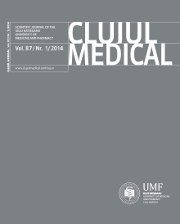Ex-vivo Perfusion Machines in Kidney Transplantation. The Significance of the Resistivity Index.
DOI:
https://doi.org/10.15386/cjm.2014.8872.871.fie1Keywords:
Graft quality, perfusion machine, post-transplant Doppler ultrasound, renal transplantationAbstract
Introduction. With a growing shortage of organs for transplantation, finding ways of increasing the donor organ pool remains of utmost importance. Perfusion machines (PM) have been proven to enhance the potential for kidney transplants to function sooner, last longer, giving patients the opportunity for a better life quality.
Objective. The aim of this study is to evaluate the relation between the resistance index provided by the PM, the postoperative resistance index measured by Doppler ultrasound and the initial graft outcome.
Material and method. Between January 2012-December 2012, clinical data obtained from 82 consecutive renal transplants from brain death donors (BDD) which underwent PM maintenance were analyzed in a transversal study. Prior transplantation we recorded the solution temperature, filtration rate and the resistance index provided by PM. After the surgical intervention, each patient had standard follow-up. Doppler ultrasound resistivity index (RI) was recorded on the first postoperative day.
Results. Out of 115 renal transplants, 98 (85.21%) were performed with grafts from BDD. The PM was used for 82 renal grafts. The Doppler resistance index in relation to the resistance index shows a highly statistical correlation by linear regression (R=0.813, p<0.0001). Primary graft function was recorded in 74 patients (90.24%) and it was highly statistically significant correlated with the resistance index measured by PM. Out of 8 patients with primary non-function, 6 patients recovered with normal graft function at one year.
Conclusion. The resistivity index recorded by the life-port machine is correlated with the vascular resistivity index measured by Doppler ultrasound and thus it may predicts the primary graft outcome.
Downloads
Published
How to Cite
Issue
Section
License
The authors are required to transfer the copyright of the published paper to the journal. This is done by agreeing to sign the Copyright Assignment Form. Whenever the case, authors are also required to send permissions to reproduce material (such as illustrations) from the copyright holder.

The papers published in the journal are licensed under a Creative Commons Attribution-NonCommercial-NoDerivatives 4.0 International License.

